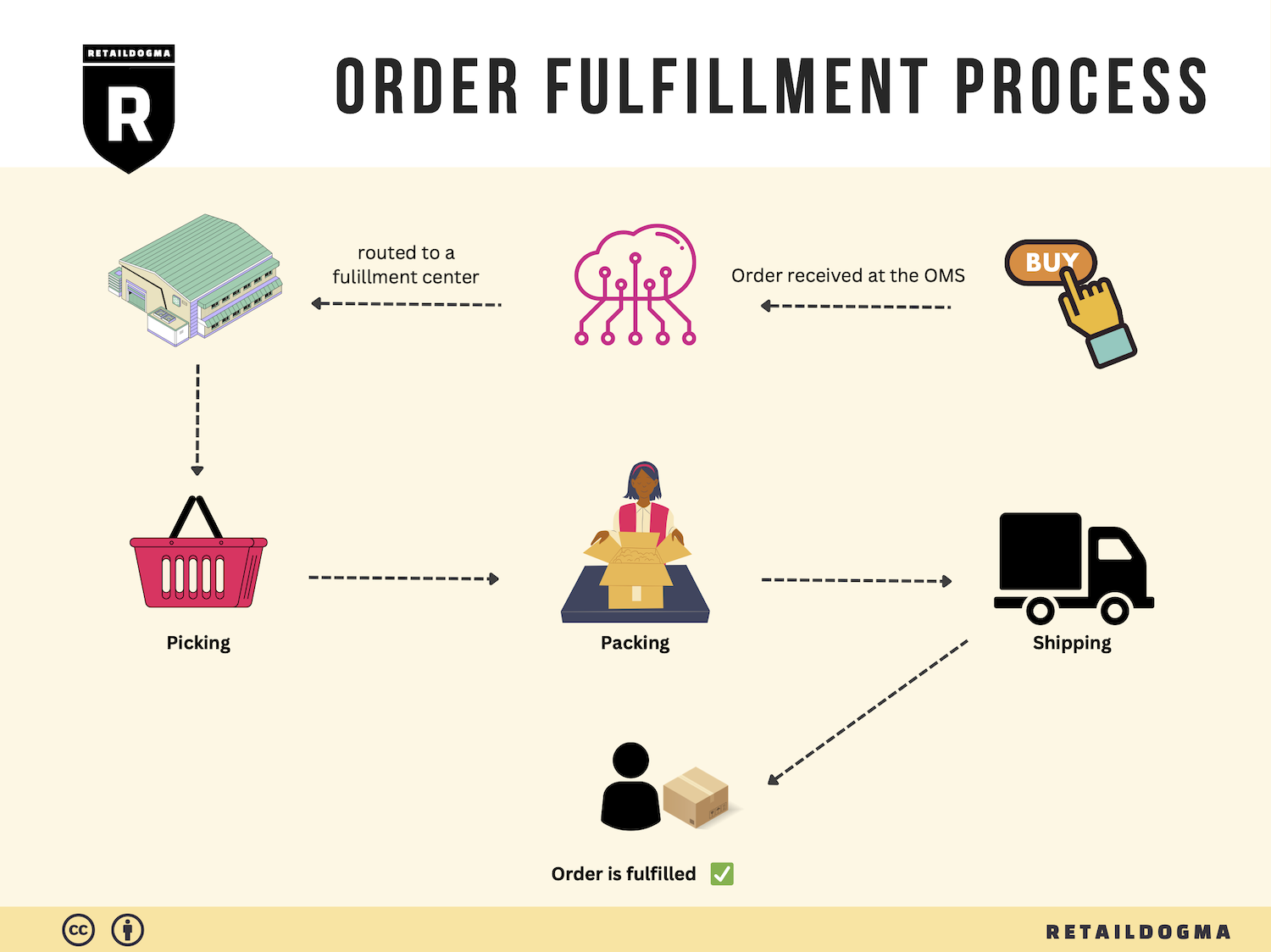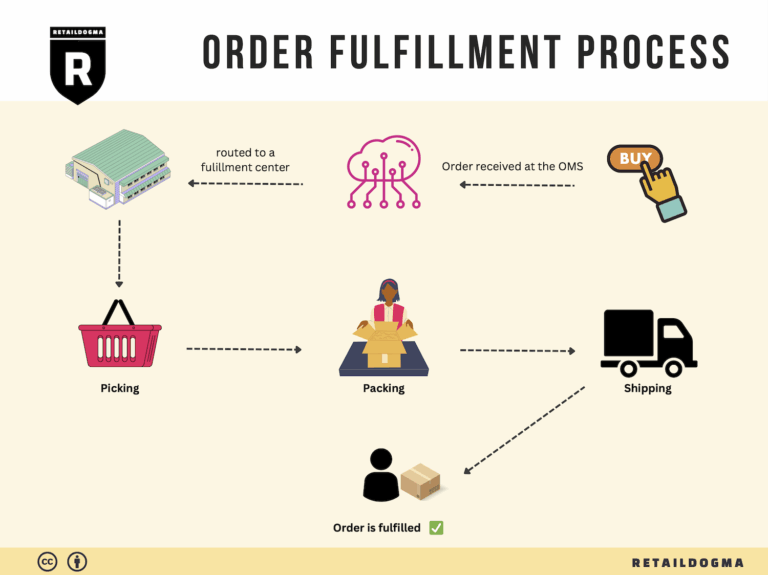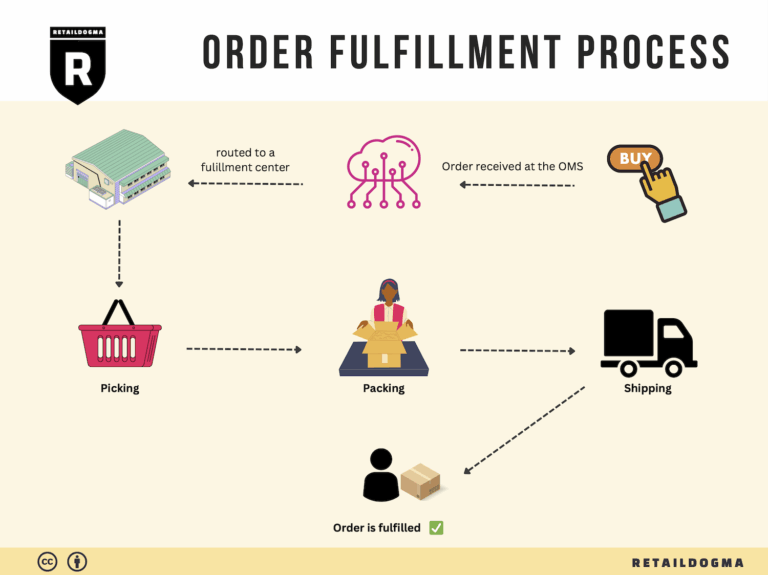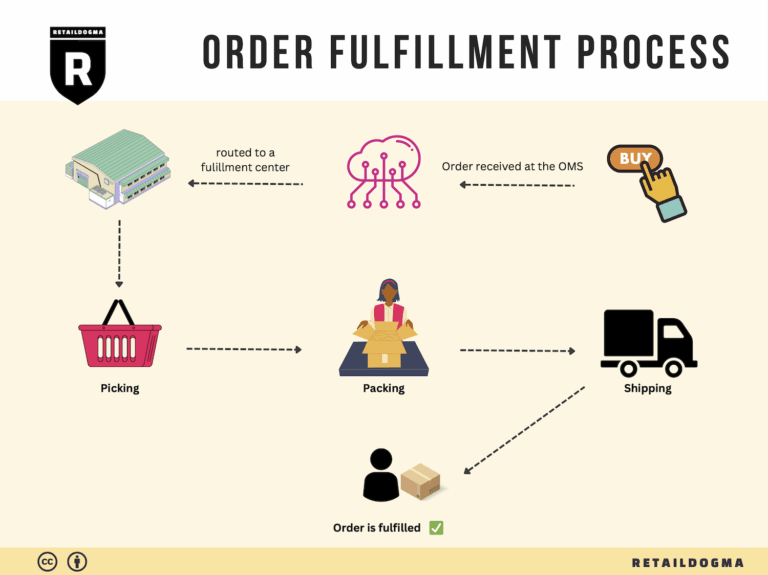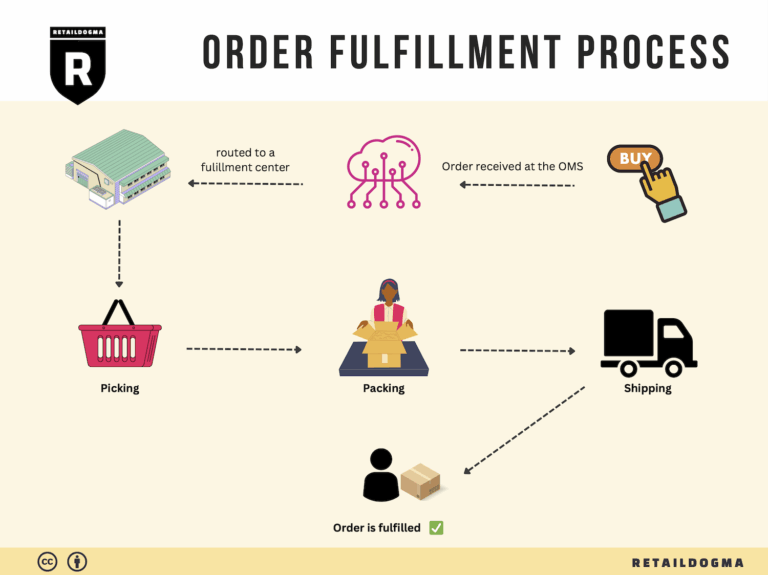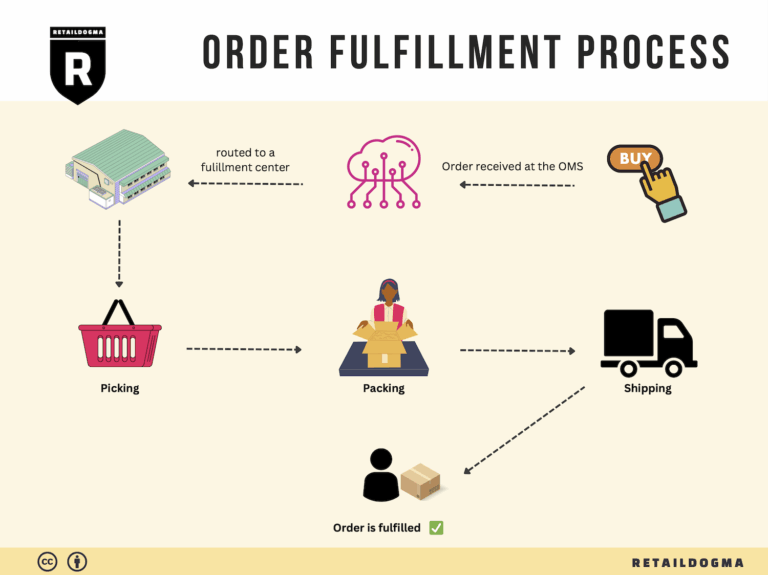How Order Fulfillment Works: A Step-by-Step Guide for Businesses
What is E-commerce Fulfillment? An Introduction for Growing Businesses
Understanding E-commerce Fulfillment
As an e-commerce business owner, you may find yourself grappling with a common challenge: the overwhelming task of packing and shipping orders. As your sales grow, so does the complexity of managing logistics. This is where e-commerce fulfillment comes into play. Simply put, fulfillment is the process of getting a product from your inventory to your customer’s doorstep. It encompasses everything from receiving inventory, processing orders, packing items, and shipping them out, to handling returns.
This guide aims to demystify e-commerce fulfillment and provide you with actionable insights to streamline your operations. We will explore various fulfillment models, including third-party logistics (3PL) and Fulfillment by Amazon (FBA), each with its unique advantages and considerations. Understanding these models is crucial as they can significantly impact your operational efficiency and customer satisfaction.
We will also break down the core services involved in the fulfillment process. These services typically include inventory management, order processing, shipping logistics, and customer service support. By understanding these components, you can identify which services are essential for your business and how they align with your growth goals.
Choosing the right fulfillment partner is another critical aspect we will cover. The right partner can help you scale your operations without compromising on quality or speed. We’ll provide you with a framework to evaluate potential partners based on factors such as location, technology, service offerings, and customer reviews.
Additionally, pricing is an essential consideration when selecting a fulfillment strategy. We will outline the various cost structures you might encounter, from storage fees to shipping costs, and provide tips on how to negotiate favorable terms with your fulfillment partner.
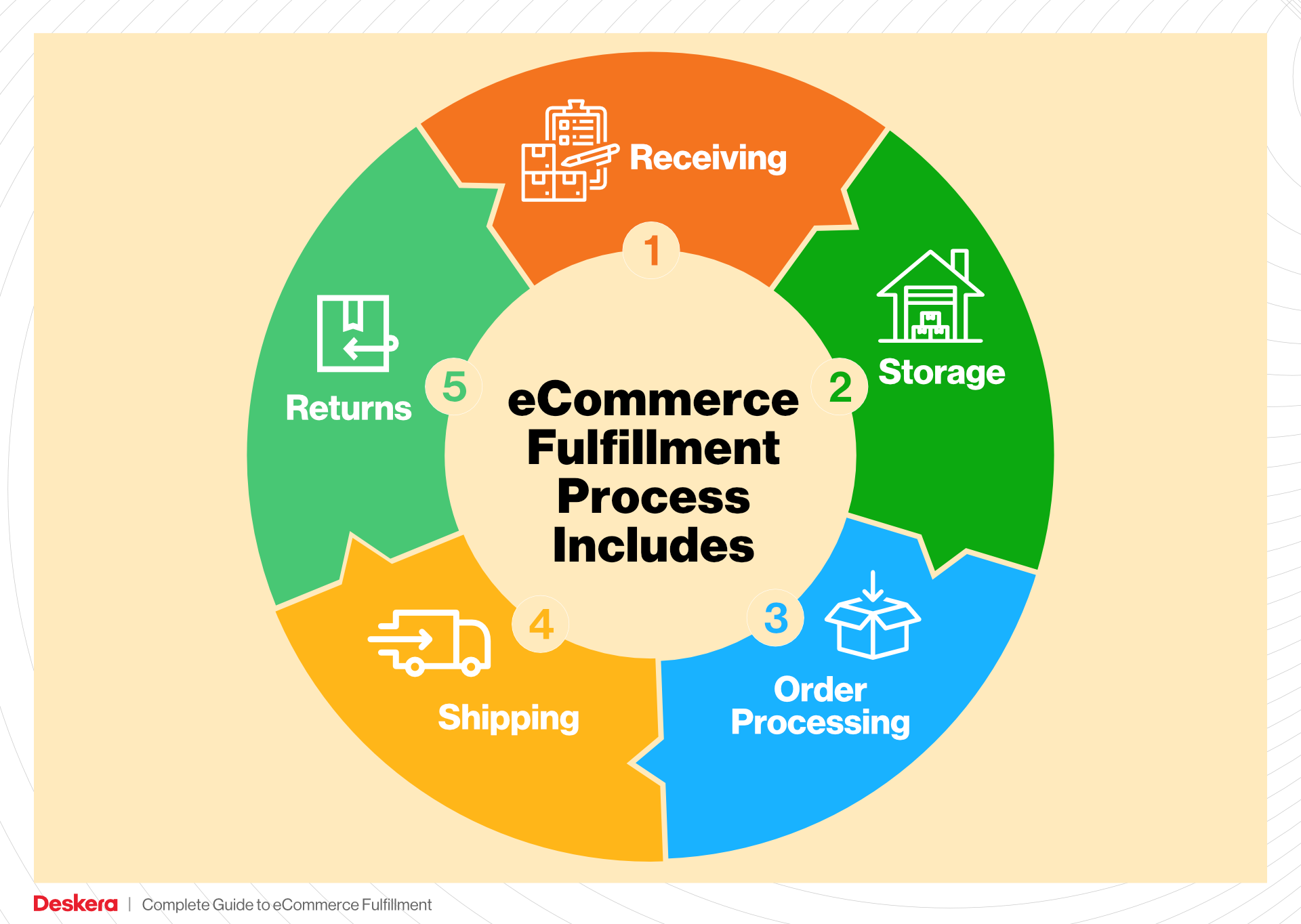
Ultimately, this guide is designed to empower you to make informed decisions about your logistics. By understanding the ins and outs of e-commerce fulfillment, you can focus on what matters most: growing your business and delighting your customers. Whether you’re a startup or an established player looking to scale, the insights provided here will help you navigate the complexities of fulfillment with confidence.
What You’ll Learn In This Guide
- What is E-commerce Fulfillment? An Introduction for Growing Businesses
- The Order Fulfillment Process: From ‘Buy’ Button to Customer’s Door
- Comparing Fulfillment Models: In-House vs. 3PL vs. Dropshipping
- A Deep Dive into Amazon FBA: Pros, Cons, and Who It’s For
- Core Services Offered by Fulfillment Centers
- How to Choose a Fulfillment Partner: A 6-Point Checklist
- Understanding Fulfillment Pricing: A Breakdown of Common Fees
- Frequently Asked Questions (FAQs) about Fulfillment
- Conclusion: Is Outsourcing Fulfillment the Right Move for Your Business?
- Important Disclaimer
The Order Fulfillment Process: From ‘Buy’ Button to Customer’s Door
1. Receiving Inventory
The order fulfillment process begins with receiving inventory at the fulfillment center, such as the Amazon Fulfillment Center-AKC1 in Akron, OH. When products arrive, they are checked against purchase orders to ensure accuracy. This step is crucial because any discrepancies can lead to inventory shortages or overages, affecting future orders.
During this phase, each item is assigned a Stock Keeping Unit (SKU), a unique identifier that streamlines tracking and management within the warehouse. Accurate receiving establishes a solid foundation for inventory control, ensuring that the right products are available when customers place orders.
2. Warehouse Storage
Once inventory is received and processed, products are stored in designated areas within the fulfillment center. Efficient warehouse storage is vital for optimizing space and facilitating easy access to items. Products are typically organized based on various factors such as size, type, and sales velocity.
Key terms in this step include bin locations and pallet racking. Bin locations refer to specific areas within the warehouse where items are stored, while pallet racking is a system used to stack products in a way that maximizes vertical space. Proper organization enhances picking efficiency, reduces retrieval time, and ultimately contributes to faster order fulfillment.
3. Order Picking
Order picking is the process of retrieving items from storage to fulfill customer orders. When an order is placed, a pick list is generated, detailing the items and their respective locations within the warehouse. This step is critical as it directly impacts the accuracy and speed of order fulfillment.
There are several picking methods, including single order picking, where one order is picked at a time, and batch picking, where multiple orders are fulfilled simultaneously. Choosing the right method depends on the volume of orders and the layout of the warehouse. Efficient picking reduces labor costs and increases order accuracy, leading to higher customer satisfaction.
4. Order Packing
Once items are picked, they move to the packing station where they are prepared for shipment. During this stage, products are carefully packed into boxes, ensuring they are secure and protected during transit. Packing is a vital step because it minimizes the risk of damage and returns, which can be costly for e-commerce businesses.

Key considerations in this phase include packing slips and dimensional weight pricing. A packing slip is included in the shipment, detailing the items enclosed, while dimensional weight pricing takes into account the size of the package for shipping costs. Efficient packing processes can significantly enhance shipping speed and reduce operational costs, making it a critical component of the order fulfillment process.
5. Shipping & Delivery
The final step in the order fulfillment process is shipping and delivery. Once packages are packed, they are labeled and handed over to shipping carriers for delivery. This phase is crucial as it directly affects customer satisfaction and the overall perception of your brand.
Key terms associated with shipping include last-mile delivery and tracking numbers. Last-mile delivery refers to the final leg of the shipping journey, where packages are delivered from a local distribution center to the customer’s doorstep. Providing tracking numbers allows customers to monitor their orders in real-time, enhancing transparency and trust.
Efficient shipping processes can lead to reduced delivery times and increased customer loyalty. By optimizing routes and utilizing advanced logistics technologies, businesses can scale their operations and improve their competitive edge in the e-commerce landscape.
In summary, understanding and optimizing each step of the order fulfillment process is essential for e-commerce businesses aiming to scale. From receiving inventory to delivering packages, each phase plays a pivotal role in ensuring customer satisfaction and operational efficiency.
Comparing Fulfillment Models: In-House vs. 3PL vs. Dropshipping
Fulfillment Model Comparison Table
| Model | Who Handles Inventory | Best For (Business Stage) | Key Advantage | Key Disadvantage |
|---|---|---|---|---|
| In-House Fulfillment | Business itself | Established businesses | Full control over inventory | Higher overhead costs |
| Third-Party Logistics (3PL) | Third-party logistics provider | Growing businesses | Scalability and expertise | Less control over operations |
| Dropshipping | Supplier | Startups and small businesses | Low upfront investment | Lower profit margins |
In-House Fulfillment
In-house fulfillment is a model where the e-commerce business manages its own inventory, storage, packing, and shipping processes. This approach is typically favored by established businesses that have sufficient resources and infrastructure to handle logistics internally. One of the primary advantages of in-house fulfillment is the level of control it offers. Businesses can manage inventory levels, quality control, and shipping processes directly, which can lead to improved customer satisfaction through faster and more reliable order fulfillment. Additionally, having direct oversight can enhance operational efficiency, allowing businesses to tailor their processes to fit their specific needs.
However, in-house fulfillment also comes with significant drawbacks. The most notable is the higher overhead costs associated with maintaining a warehouse, hiring staff, and investing in technology for inventory management and order processing. These costs can be particularly burdensome for smaller businesses or those experiencing fluctuations in demand. Moreover, as order volumes grow, the complexity of managing logistics in-house can lead to operational challenges, potentially hindering the ability to scale efficiently.
Third-Party Logistics (3PL)
Third-party logistics (3PL) involves outsourcing the storage, fulfillment, and shipping processes to an external logistics provider. This model is particularly beneficial for growing businesses that seek to scale operations without the burden of managing logistics internally. A key advantage of utilizing a 3PL is the scalability it offers. As businesses grow and their order volumes increase, 3PL providers can adjust services accordingly, providing additional space and resources as needed. Furthermore, 3PL companies often have extensive expertise in logistics management, enabling businesses to leverage their knowledge for improved efficiency and cost-effectiveness.
On the downside, relying on a 3PL can result in less control over inventory and fulfillment processes. Businesses may face challenges in ensuring that their brand standards are upheld, as they are dependent on the provider’s practices and systems. Communication can also become a hurdle, especially if the 3PL is located far from the business’s operations. Additionally, while 3PLs can help reduce overhead costs, businesses must still manage the costs associated with outsourcing, which can add up, especially if service levels need to be increased or if there are unexpected fees.
Dropshipping
Dropshipping is a fulfillment model where the e-commerce business does not hold inventory but instead relies on suppliers to ship products directly to customers. This model is particularly appealing for startups and small businesses, as it requires minimal upfront investment. Entrepreneurs can focus on marketing and sales without the need to invest in inventory or warehouse space, reducing financial risk significantly. Additionally, dropshipping allows for a wide range of products to be offered without the burden of managing stock, making it easier to pivot or expand product lines quickly.
However, dropshipping also comes with notable disadvantages. One of the main challenges is the lower profit margins, as suppliers typically charge higher prices for the convenience of direct shipping. Furthermore, businesses have limited control over inventory levels and fulfillment processes, which can lead to issues such as stockouts or delays in shipping. Customer service can also be complicated, as any issues with the product or shipping need to be resolved through the supplier, potentially leading to longer resolution times and dissatisfaction among customers. This lack of control over the supply chain can hinder a business’s ability to deliver a consistent customer experience, which is crucial for building brand loyalty.
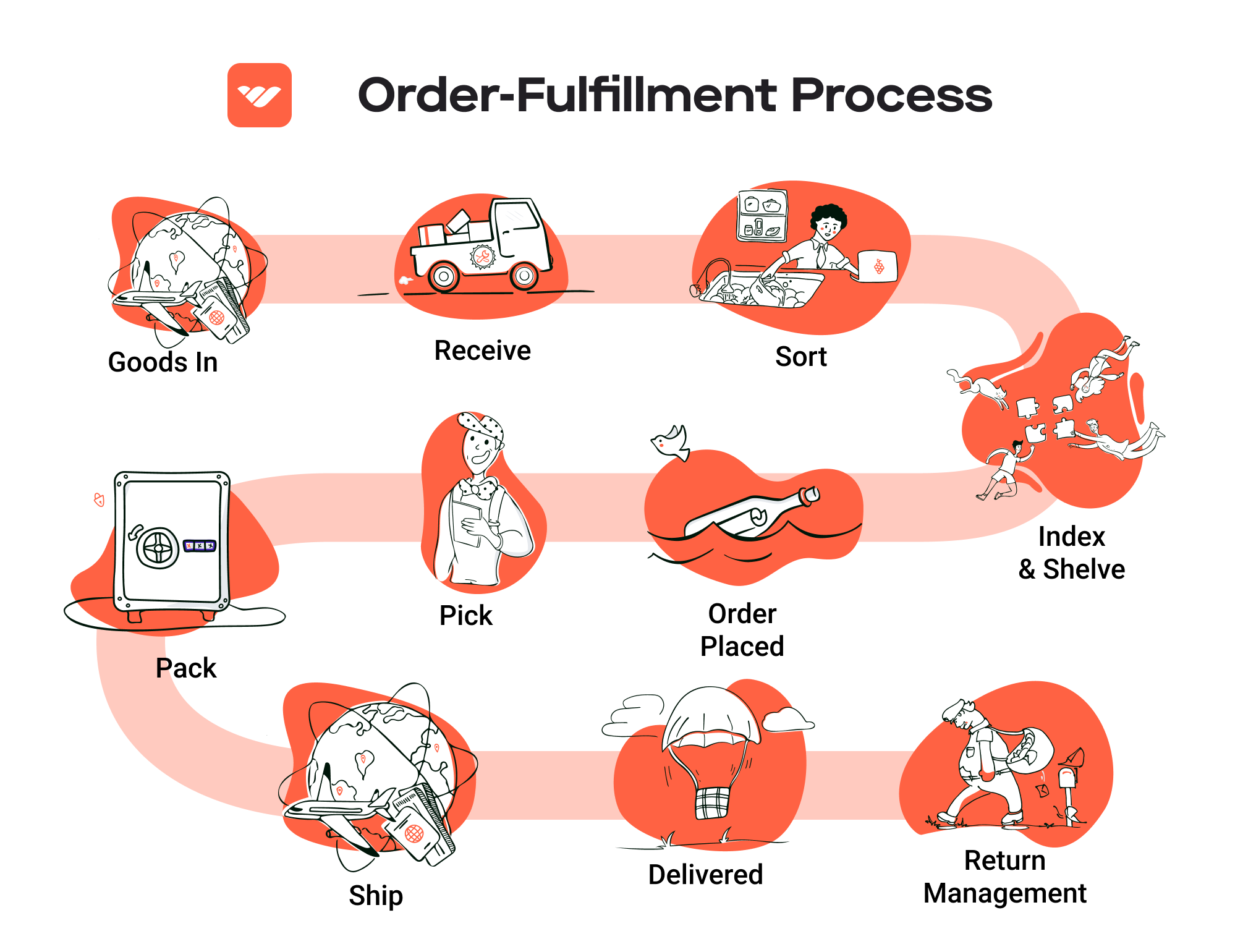
Conclusion
When choosing a fulfillment model, e-commerce businesses must consider their current stage, resources, and long-term goals. In-house fulfillment offers control but comes with high costs, while 3PLs provide scalability and expertise but may dilute brand control. Dropshipping is an accessible entry point for many startups, but it requires careful management of supplier relationships and profit margins. Ultimately, the right choice will depend on the unique circumstances and objectives of the business.
A Deep Dive into Amazon FBA: Pros, Cons, and Who It’s For
Understanding Fulfillment by Amazon (FBA)
Fulfillment by Amazon (FBA) is a service that allows e-commerce sellers to store their products in Amazon’s fulfillment centers. Amazon then takes care of storage, packaging, shipping, and customer service on behalf of the sellers. This service is particularly beneficial for businesses looking to scale their operations without the overhead of managing logistics themselves.
When a customer places an order for a product listed through FBA, Amazon handles the entire process—from picking the item from the warehouse to shipping it to the customer. Sellers benefit from Amazon’s vast logistics network, enabling faster delivery times and access to Amazon’s customer service resources.
How FBA Works
-
Product Listing: Sellers create product listings on Amazon and choose to enroll their products in the FBA program.
-
Inventory Shipment: Sellers ship their products to Amazon’s fulfillment centers. Amazon provides specific guidelines on how to package and label products for storage.
-
Storage: Once received, products are stored in Amazon’s warehouses until sold.
-
Order Processing: When a customer places an order, Amazon picks, packs, and ships the product on behalf of the seller.
-
Customer Service: Amazon also handles customer inquiries and returns, providing a seamless experience for both sellers and customers.
Pros of Using FBA
-
Prime Eligibility: Products fulfilled by Amazon are eligible for Amazon Prime, which can significantly increase sales. Prime members often prefer items that offer fast, free shipping.
-
Customer Trust: Amazon is a trusted brand, and customers often feel more secure purchasing products that are fulfilled by Amazon. This can lead to higher conversion rates and more repeat business.
-
Multi-Channel Fulfillment: FBA allows sellers to fulfill orders from multiple sales channels, not just Amazon. This means that if you sell on your website or other platforms, you can still use Amazon’s logistics to ship those orders.
-
Scalability: FBA allows businesses to scale without worrying about logistics. As sales grow, Amazon can handle increased order volumes, enabling sellers to focus on marketing and product development.
-
Streamlined Operations: By outsourcing storage, packing, and shipping, sellers can reduce the time and resources spent on logistics, allowing them to concentrate on other core business functions.
Cons of Using FBA
-
High Fees: FBA comes with various fees, including storage fees for items stored in Amazon’s warehouses and fulfillment fees for each order processed. These costs can add up, especially for low-margin products.
-
Strict Inventory Rules: Amazon has specific guidelines and restrictions regarding inventory management. Sellers must adhere to these rules to avoid penalties, which can be challenging for those unfamiliar with Amazon’s policies.
-
Commingling Risks: In some cases, Amazon commingles inventory from multiple sellers. This means that a seller’s product could be shipped to customers from another seller’s stock, which can lead to issues with product quality control and brand reputation.
-
Limited Control: By utilizing FBA, sellers relinquish some control over the fulfillment process. This can be a disadvantage for businesses that prefer to manage their shipping and customer service directly.
-
Storage Limitations: Amazon imposes limits on the amount of inventory a seller can store in its fulfillment centers, particularly during peak seasons. This can restrict sales potential if not managed properly.
Who is FBA Best For?
Fulfillment by Amazon is best suited for:
-
Small to Medium-Sized Businesses: Companies that lack the resources to manage logistics in-house can benefit from FBA’s extensive infrastructure. It allows them to offer competitive shipping options without significant investment in warehousing and distribution.
-
Brands Seeking Growth: For brands looking to scale quickly, FBA provides the tools necessary to reach a larger audience without the logistical burden. This is particularly valuable during peak shopping seasons, such as the holidays.
-
Sellers of High-Demand Products: Businesses that sell high-volume or seasonal products can leverage FBA to handle the spikes in demand effectively. The ability to offer Prime shipping can also enhance sales for these products.
-
Multi-Channel Sellers: Businesses that sell across various platforms can benefit from Amazon’s logistics while maintaining a presence outside of Amazon’s marketplace.
-
Entrepreneurs Focused on Efficiency: For sellers who wish to focus on product development, marketing, and customer engagement rather than logistics, FBA offers a streamlined approach to fulfillment.
In conclusion, Fulfillment by Amazon is a powerful tool for e-commerce businesses aiming to enhance their logistics capabilities and scale their operations. While it comes with its share of costs and challenges, the benefits of utilizing Amazon’s infrastructure often outweigh the drawbacks for many sellers, especially those looking to grow their reach and streamline their operations.
Core Services Offered by Fulfillment Centers
Inventory Management & Warehousing
Inventory management and warehousing are foundational services provided by fulfillment centers. This involves not only the physical storage of products but also the systematic control of stock levels. Fulfillment centers utilize advanced inventory management systems to track product quantities, monitor stock movements, and manage reordering processes.
Benefits:
1. Real-time Visibility: E-commerce businesses gain access to real-time data on inventory levels, which allows for informed decision-making regarding stock replenishment and sales forecasting.
2. Reduced Storage Costs: By outsourcing warehousing needs, businesses can significantly reduce overhead costs associated with maintaining their own storage facilities.
3. Scalability: As your business grows, fulfillment centers can easily adjust to increased inventory demands without the need for major capital investments in additional storage space.
4. Improved Accuracy: Automated inventory tracking reduces human error, ensuring that stock levels are accurate and minimizing the risk of stockouts or overstock situations.
Pick and Pack Services
Pick and pack services refer to the process of selecting items from inventory (picking) and packaging them for shipment (packing). Fulfillment centers streamline this process using technology and organized workflows to ensure efficiency. When an order is placed, the fulfillment center picks the items from their inventory, carefully packs them, and prepares them for shipping.
Benefits:
1. Speed and Efficiency: Fulfillment centers are equipped with optimized picking systems that speed up the order fulfillment process. This is crucial for e-commerce businesses that promise fast shipping to customers.
2. Quality Control: Many fulfillment centers implement quality control measures during the packing process, reducing the likelihood of errors such as incorrect items or damaged goods being shipped.
3. Custom Packaging Solutions: Fulfillment centers often offer custom packaging options, which can enhance branding and improve the customer experience. This includes branded boxes, packing slips, and other promotional materials.
4. Cost-Effective Shipping: By consolidating orders and utilizing established shipping partnerships, fulfillment centers can often provide better shipping rates than individual businesses could secure on their own.
Kitting and Assembly
Kitting and assembly services involve the grouping of multiple products into a single package or the assembly of components into a finished product. This service is particularly beneficial for e-commerce businesses that sell products requiring assembly or combination, such as gift sets or customized kits.
Benefits:
1. Enhanced Product Offerings: Kitting allows businesses to create unique product bundles that can increase sales and attract more customers. For example, bundling complementary items can encourage customers to purchase more.
2. Streamlined Operations: By outsourcing kitting and assembly, businesses can focus on their core competencies, such as marketing and customer service, rather than the complexities of product assembly.
3. Reduced Time to Market: Fulfillment centers can quickly assemble products and prepare them for shipment, enabling businesses to respond faster to market demands and consumer trends.
4. Inventory Simplification: Kitting can simplify inventory management by reducing the number of individual SKUs a business has to track, as multiple items can be sold as a single kit.
Returns Management (Reverse Logistics)
Returns management, also known as reverse logistics, is the process of handling product returns efficiently. Fulfillment centers provide services to manage returns, including receiving returned items, inspecting them, restocking them, or processing them for disposal or recycling.
Benefits:
1. Customer Satisfaction: Efficient returns management is crucial for maintaining customer satisfaction. A streamlined return process can enhance the overall customer experience and encourage repeat business.
2. Cost Reduction: By effectively managing returns, fulfillment centers can minimize losses associated with returned merchandise. They can assess the condition of returned items and determine the most cost-effective way to handle them.
3. Data Insights: Analyzing return patterns can provide valuable insights into product quality, customer preferences, and potential issues with items. This data can inform product development and inventory decisions.
4. Brand Loyalty: A hassle-free return process can foster customer loyalty, as consumers are more likely to return to a business that makes returns easy and straightforward.
In summary, partnering with a fulfillment center for these core services allows e-commerce businesses to streamline operations, reduce costs, and enhance customer satisfaction, all of which are critical components for scaling in today’s competitive online marketplace.
How to Choose a Fulfillment Partner: A 6-Point Checklist
Location & Warehouse Network
Importance:
The location of your fulfillment partner’s warehouses is crucial for ensuring timely delivery and minimizing shipping costs. A partner with strategically placed warehouses can help you reach your customers faster, particularly if you serve a wide geographic area.
Questions to Ask:
– Where are your warehouses located, and how do they align with my target customer base?
– Do you have plans to expand your warehouse network in the near future?
– What is the average shipping time to various regions from your fulfillment centers?
Technology & Integrations
Importance:
In today’s digital landscape, having a robust technology platform is essential. Your fulfillment partner should provide seamless integration with your e-commerce platform, inventory management systems, and customer relationship management tools. This ensures a smooth flow of information and helps maintain accurate inventory levels.
Questions to Ask:
– What technology platforms do you use, and how do they integrate with my existing systems?
– Can you provide real-time tracking and reporting tools?
– How often do you update your technology, and what is your process for adopting new tools?
Specializations (e.g., cold storage, oversized items)
Importance:
Depending on the nature of your products, you may require a fulfillment partner with specialized capabilities, such as cold storage for perishable goods or handling oversized items. Choosing a partner with the right specializations can prevent potential issues and ensure compliance with safety regulations.
Questions to Ask:
– What types of specialized services do you offer (e.g., temperature-controlled storage, hazardous materials handling)?
– Can you handle my specific product types, and what experience do you have with similar items?
– Are there any certifications or compliance measures in place for specialized storage?
Scalability & Capacity
Importance:
As your business grows, your fulfillment partner must be able to scale alongside you. A partner with adequate capacity can accommodate seasonal spikes in demand without compromising service quality. Scalability also includes the ability to adapt to changes in your business model or product range.
Questions to Ask:
– What is your current capacity, and how do you handle peak seasons?
– How quickly can you scale operations if my order volume increases?
– Do you have contingency plans in place for unexpected spikes in demand?
Pricing and Contracts
Importance:
Understanding the pricing structure is vital for budgeting and maintaining profit margins. Look for transparency in pricing and be wary of hidden fees. Additionally, the terms of the contract should align with your business goals and growth projections.
Questions to Ask:
– What is your pricing structure, and are there any additional fees I should be aware of?
– How do you handle pricing adjustments based on order volume or service changes?
– What are the terms of the contract, and can it be modified as my business evolves?
Customer Support & Reviews
Importance:
Effective communication and support from your fulfillment partner can significantly impact your operational efficiency. A responsive customer support team can help resolve issues quickly and maintain a positive customer experience. Additionally, researching reviews can provide insights into the partner’s reliability and service quality.
Questions to Ask:
– What customer support channels do you offer (e.g., phone, email, chat)?
– What is your average response time for support inquiries?
– Can you provide references or testimonials from other clients in my industry?
Conclusion
Choosing the right fulfillment partner is a critical decision that can greatly influence your e-commerce success. By systematically evaluating potential partners against this checklist, you can ensure that your chosen fulfillment provider aligns with your business needs, supports your growth, and enhances your customer satisfaction. Take your time to conduct thorough research and ask the right questions to find a partner that can help you scale effectively.
Understanding Fulfillment Pricing: A Breakdown of Common Fees
Initial Setup Fees
Initial setup fees are typically charged when you first begin using a fulfillment service. These fees can vary significantly depending on the provider and the complexity of your operations. Generally, they cover the cost of onboarding your account, integrating your systems with the fulfillment center’s technology, and any necessary training for your staff.
Calculation: Setup fees can be a flat rate or based on the number of products you plan to send to the fulfillment center. For example, if you have a large catalog or multiple SKUs, you may incur higher fees due to the additional work involved in setting up your account.
Receiving Fees
Receiving fees are charged when your inventory arrives at the fulfillment center. This fee covers the labor costs of unloading, inspecting, and storing your products. Understanding this fee is crucial, as it can significantly affect your overall fulfillment costs, especially if you frequently send large shipments.
Calculation: Receiving fees are usually based on the volume of goods being received, often calculated per pallet or per unit. For example, if you send 10 pallets of goods, and the fee is $20 per pallet, your total receiving fee will be $200. Some fulfillment centers may also charge additional fees for special handling or inspection.
Storage Fees (per pallet/bin)
Storage fees are charged for the space your inventory occupies within the fulfillment center. These fees are essential for understanding your ongoing costs, as they can accumulate over time, particularly if you have slow-moving inventory.
Calculation: Storage fees are commonly calculated on a monthly basis, either per pallet or per cubic foot. For example, if a fulfillment center charges $10 per pallet per month and you have 5 pallets stored, your monthly storage fee would be $50. Keep in mind that some providers may offer tiered pricing, where the rate decreases as you store more pallets.
Pick & Pack Fees (per item/order)
Pick and pack fees are charged for the labor involved in retrieving your products from storage and packaging them for shipment. This fee is critical to your fulfillment pricing, especially if you have a high volume of orders or a diverse range of products.
Calculation: Pick and pack fees can be structured in a few ways: a flat fee per order, a fee per item picked, or a combination of both. For instance, a fulfillment center might charge $2 per order plus $0.50 for each item picked. If an order consists of 3 items, the total pick and pack fee would be $3.50. Understanding this fee structure can help you better manage your costs as your order volume fluctuates.
Shipping Fees
Shipping fees cover the cost of transporting your products to customers. This is often one of the most significant components of fulfillment pricing, especially for e-commerce businesses that offer free shipping or expedited delivery options.
Calculation: Shipping fees can vary widely based on factors such as package dimensions, weight, destination, and the shipping method selected (e.g., standard, expedited, or overnight). Many fulfillment centers negotiate rates with carriers, which can help you save on shipping costs. It’s vital to compare these rates and understand the pricing model to avoid surprises when shipping large volumes.
Tips for Getting an Accurate Quote
-
Be Transparent About Your Needs: When requesting a quote, provide detailed information about your product types, order volumes, and any special handling requirements. This will help fulfillment providers offer a more accurate estimate.
-
Ask About All Fees: Inquire about all potential fees, including those for returns, special packaging, or long-term storage. Understanding the full scope of costs will help you budget effectively.
-
Request a Cost Breakdown: A detailed breakdown of each fee type will help you understand where your money is going and allow you to identify areas for potential savings.
-
Compare Multiple Providers: Don’t settle for the first quote you receive. Compare offers from multiple fulfillment centers to ensure you’re getting the best deal for your needs.
-
Review Your Contract Regularly: Fulfillment pricing can change, so it’s essential to review your contract and terms regularly to ensure they still align with your business goals.
By understanding these common fees and how they are calculated, e-commerce business owners can make informed decisions when selecting a fulfillment partner, ultimately leading to more efficient operations and better profit margins.
Frequently Asked Questions (FAQs) about Fulfillment
1. What services does Amazon Fulfillment Center AKC1 offer?
Amazon Fulfillment Center AKC1 specializes in storing, picking, packing, and shipping a diverse range of products for e-commerce businesses. It integrates advanced technology and efficient processes to ensure rapid order fulfillment, making it a crucial part of Amazon’s logistics network.
2. How does Amazon Fulfillment Center AKC1 ensure timely deliveries?
The center employs state-of-the-art technology and streamlined operational processes, including automated sorting systems and efficient inventory management. These technologies work together to minimize delays and enhance the speed of order processing and shipping.
3. What’s the difference between a warehouse and a fulfillment center?
A warehouse primarily focuses on storing goods, while a fulfillment center is designed to handle the entire order fulfillment process, including storage, order picking, packing, and shipping directly to customers. Fulfillment centers often prioritize speed and efficiency to meet the demands of e-commerce.
4. What is a 3PL (Third-Party Logistics)?
A 3PL is a service provider that manages a company’s logistics and supply chain operations. This includes warehousing, fulfillment, transportation, and distribution of goods. Businesses often partner with 3PLs like Amazon to leverage their infrastructure and expertise to scale their operations efficiently.
5. How much do fulfillment services cost?
Fulfillment service costs vary based on several factors, including order volume, storage space required, and specific services needed (like kitting or custom packaging). On average, businesses can expect to pay for storage, picking, packing, and shipping fees, which can range from a few dollars per order to more substantial monthly fees depending on the scale of operations.
6. Can I track my inventory at Amazon Fulfillment Center AKC1?
Yes, Amazon provides tools and dashboards for businesses to monitor their inventory levels in real time. This allows sellers to manage stock efficiently and avoid stockouts or overstock situations.
7. What are the benefits of using Amazon Fulfillment Center AKC1 for my e-commerce business?
Utilizing Amazon Fulfillment Center AKC1 offers several advantages, including access to Amazon’s extensive logistics network, faster shipping times (including Prime eligibility), reduced shipping costs through bulk shipping rates, and the ability to scale operations without the need for significant upfront investment in warehousing.
8. How do I get my products to Amazon Fulfillment Center AKC1?
Sellers can ship their products directly to the fulfillment center. Amazon provides guidelines on packaging and shipping requirements to ensure that products arrive safely and are ready for processing upon arrival.
9. What types of products can be stored at Amazon Fulfillment Center AKC1?
The center can accommodate a wide range of products, including electronics, clothing, household items, and more. However, certain restrictions apply to hazardous materials, perishables, and products that do not comply with Amazon’s policies.
10. How does Amazon handle returns at Fulfillment Center AKC1?
Amazon has a streamlined returns process, allowing customers to easily return products. Returned items are sent back to the fulfillment center, where they are inspected and either restocked or processed for disposal, depending on their condition. This efficient handling of returns helps maintain customer satisfaction and seller inventory accuracy.
Conclusion: Is Outsourcing Fulfillment the Right Move for Your Business?
Evaluating the Benefits of Outsourcing Fulfillment
Outsourcing your fulfillment can be a strategic move that offers several key benefits crucial for scaling your e-commerce business. First and foremost, utilizing a fulfillment service can save you significant time. By delegating the logistics of storage, packing, and shipping to a specialized partner, you can redirect your focus to core business activities like marketing, product development, and customer engagement. This shift not only enhances productivity but also allows for more strategic decision-making.
Additionally, partnering with a fulfillment center provides the scalability necessary for growth. As your sales volume increases, a proficient fulfillment service can seamlessly adjust to your changing needs, ensuring that your operations remain efficient and responsive. This flexibility is vital in today’s fast-paced e-commerce environment, where customer expectations for quick delivery are ever-increasing.
Moreover, outsourcing fulfillment brings expertise that many small to medium-sized businesses may lack internally. Fulfillment centers, such as Amazon Fulfillment Center-AKC1, utilize advanced technology and established processes that streamline order handling and improve accuracy. Leveraging their expertise can lead to better inventory management, reduced shipping costs, and enhanced customer satisfaction.
However, it is crucial to select the right fulfillment partner that aligns with your business goals and values. A strategic partnership can drive your growth trajectory, while a poor choice can hinder your operations and customer experience.
To determine whether outsourcing fulfillment is the right next step for your business, consider conducting a thorough audit of your current shipping and logistics processes. Evaluate the time and resources you allocate to fulfillment and identify areas for improvement. This analysis can provide clarity on whether a fulfillment service could enhance your operational efficiency and support your growth ambitions. Don’t hesitate—take action today to set your business on the path to scalable success.
Important Disclaimer
⚠️ Important Disclaimer
The information in this guide is for educational purposes. Fulfillment services, pricing, and platform features change frequently. Always conduct your own due diligence and consult with providers directly before making business decisions.
